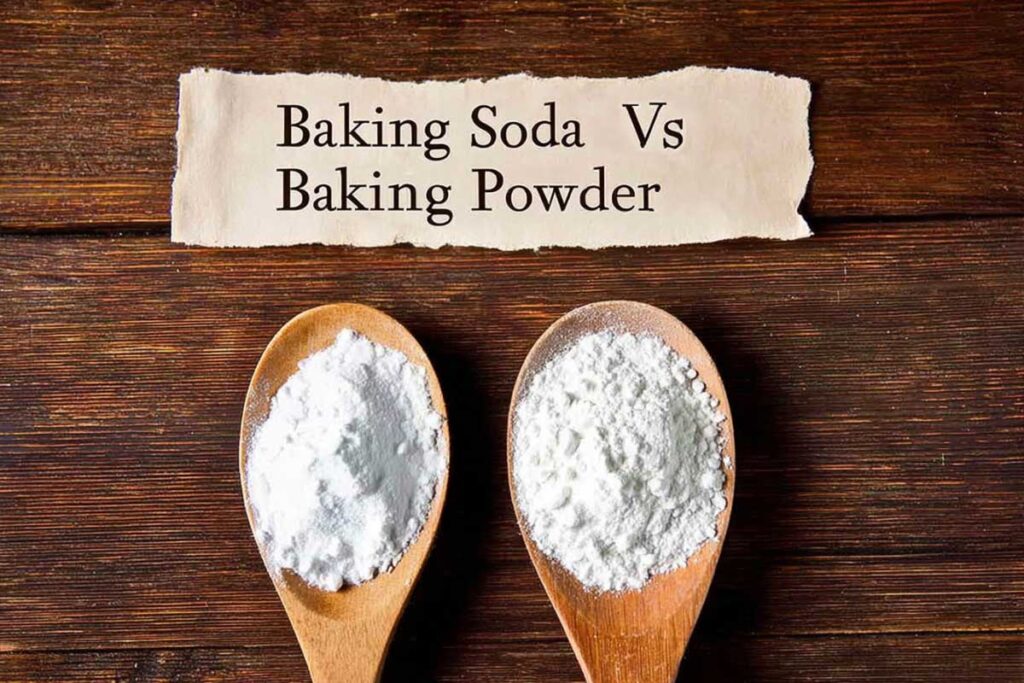Why I Finally Had to Learn the Difference Between Baking Powder and Baking Soda
I used to think the two white powders on my baking shelf were interchangeable, until a batch of banana bread emerged flat, gummy, and strangely salty. That kitchen flop sent me on a mission to crack the difference between baking powder and baking soda once and for all. If you have ever stared at a recipe wondering which jar to grab, this guide is for you.
The One-Glance Cheat Sheet
| Leavener | What’s Inside | When It Reacts | Best For |
|---|---|---|---|
| Baking soda (sodium bicarbonate) | Pure base | Touches an acid + heat | Buttermilk pancakes, molasses cookies |
| Baking powder | Baking soda + dry acid + starch | Moisture first, heat later | Vanilla cakes, biscuits, muffins |
Key takeaway: Baking soda needs an acidic buddy such as yogurt or lemon juice, while baking powder brings its own built-in acid.
Side-by-Side Muffin Test: Baking Powder vs Baking Soda
I baked two identical blueberry muffin batches this morning; only the leavener changed.
- Baking-soda batch: Needed 1 cup of buttermilk for acidity. Tall domes but a slight tang.
- Baking-powder batch: Rose evenly without extra acid, tasted lighter and sweeter.
Verdict: Both work, yet baking powder keeps flavor neutral and foolproof for recipes without buttermilk or citrus.
How Each Leavener Works (Plain-English Science)
Difference Between Baking Powder and Baking Soda Explained
- Baking soda: A single ingredient that releases carbon dioxide as soon as it meets an acid. Stir it into lemony cake batter, and bubbles start fizzing right away, so get that pan in the oven fast.
- Baking powder: A premixed package of base, dry acid (often monocalcium phosphate), and cornstarch. Most grocery brands are double-acting: they puff a little at room temperature, then rise again in the oven.
When to Use One, Both, or Neither
- Reach for baking soda when your batter already contains sour cream, molasses, brown sugar, or citrus.
- Reach for baking powder when the recipe is low-acid, like vanilla cupcakes or plain biscuits.
- Use both in chocolate cakes, gingerbread, or thick cookies: soda neutralizes acid for flavor, powder adds extra lift.
Quick Substitution Chart
| Have | Need | Swap Ratio | Tip |
|---|---|---|---|
| Baking soda | Baking powder | Use 3 tsp powder for every 1 tsp soda, and cut ⅛ tsp salt | May taste sweeter |
| Baking powder | Baking soda | Use ⅓ tsp soda per 1 tsp powder, add 1 tsp lemon juice per cup flour | Watch browning |
Five Mistakes I Made (So You Don’t Have To)
- Measuring by eye instead of leveling the spoon.
- Swapping leaveners in delicate macarons, resulting in pancake-flat shells.
- Ignoring the “best by” date; weak powder equals dense bread.
- Storing jars above the stove, humidity zaps fizz.
- Adding both leaveners without balancing acidity, yielding soapy flavor.
Shelf-Life Tips and Freshness Tests
- Baking soda: Stays potent about 18 months. Test with a splash of vinegar; fresh soda bubbles instantly.
- Baking powder: Good for 12 months. Check by stirring ½ tsp into hot water; lively fizz means you’re good.
- Store both in a cool, dry cupboard, lids tight.
FAQs
Can I clean with baking powder?
Stick to baking soda for cleaning, its coarse texture and pure base work better.
Is aluminum-free powder worth it?
Many bakers prefer it for a cleaner taste in light-flavored cakes.
Is baking soda the same as washing soda?
No; washing soda is sodium carbonate, stronger and not for food.
Key Takeaways
The difference between baking powder and baking soda boils down to acid: soda needs an external one, powder carries its own. Master that principle, and you’ll never suffer sad, flat bakes again. Print the cheat sheet, tape it inside your cupboard, and happy rising.
More on Blufashion
- Naked Fitness: Pros, Cons, and Where to Try It
- How Medical Alert Jewelry Can Play a Crucial Role in Your Health Care






